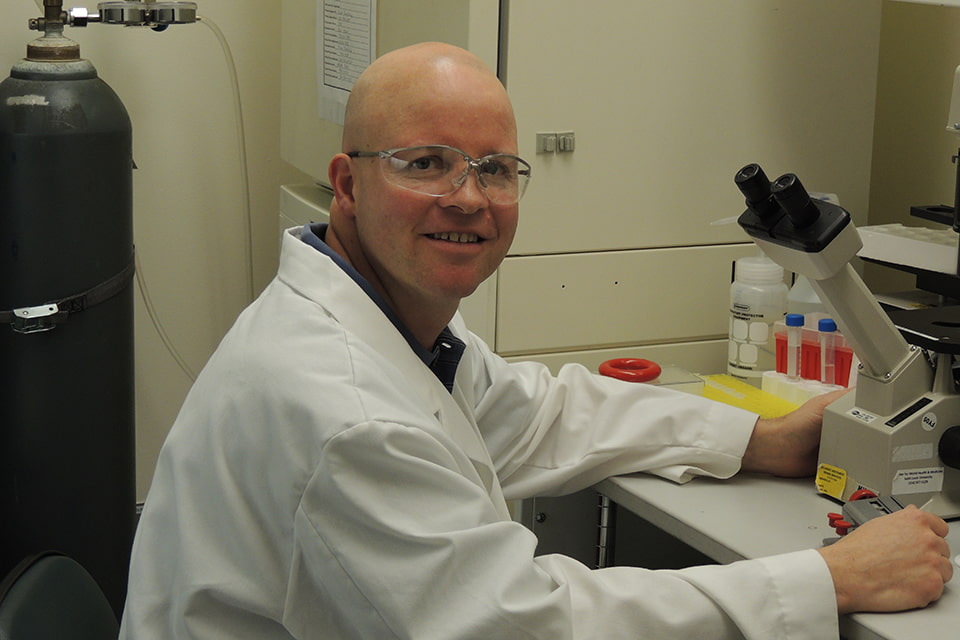In Lab, SLU Research Halts Toxic Protein Linked to Muscular Dystrophy
Carrie Bebermeyer
Public Relations Director
carrie.bebermeyer@slu.edu
314-977-8015
Reserved for members of the media.
There is no cure or treatment for facioscapulohumeral muscular dystrophy (FSHD), an illness that starts with facial, shoulder and upper arm weakness and eventually affects nearly all skeletal muscles of those with the disease. But, Saint Louis University researchers are in pursuit of a way to shut down the toxic protein that leads to the illness.
In findings published in the Journal of Pharmacology and Experimental Therapeutics, lead author Fran Sverdrup, Ph.D., associate professor of biochemistry and molecular
biology at Saint Louis University, reports that his team has successfully halted the
expression of the culprit protein in cell and animal models.
Sverdrup, who was motivated to search for a cure for FSHD after his own daughter
was diagnosed with the illness, is encouraged by the findings, which suggest a way
forward in developing the first treatment or cure for FSHD.
“We have been working to find a safe drug that would ‘turn off’ the toxic gene that
causes FSHD,” Sverdrup said. "Now we have demonstrated that we can do this in an animal
model with a drug that can be taken in pill form."
In normal skeletal muscle, the DUX4 gene is silenced. In patients with FSHD, however,
the misexpression of this gene leads to cell death and muscle degeneration. Scientist
have been searching for a way to prevent DUX4’s expression as a way to halt or reverse
the course of the disease.
Sverdrup’s team found that repurposing an existing drug, a clinically advanced p38
inhibitor, suppressed toxic DUX4 expression in cell and animal models.
Offering further cause for optimism, a biopharmaceutical company has begun a clinical
trial of the p38 inhibitor losmapimod in patients, further testing this approach and
potentially bringing a cure closer to those who need it.
Other researchers on the study include Jonathan Oliva, Scott Galasinski, Amelia Richey, Amy
E. Campbell, Marvin J. Meyers, Neal Modi, Jun Wen Zhong, Rabi Tawil and Stephen J.
Tapscott.
Sverdrup’s research was supported, in part, by a Saint Louis University Research
Institute grant. The award funded a new state-of-the-art near-infrared laserpoint
scanner that provides high sensitivity and reliable signals for laboratory work.
The paper’s digital object identifier (DOI) is: https://doi.org/10.1124/jpet.119.259663.
TAKE AWAYS:
- There is no cure or treatment for facioscapulohumeral muscular dystrophy (FSHD).
- The muscle degeneration associated with FSHD is caused by the misexpression of the DUX4 gene.
- SLU researchers found that a p38 inhibitor suppressed toxic DUX4 expression in cell and animal models.
- A biopharmaceutical company has begun a clinical trial of the p38 inhibitor losmapimod in patients, further testing this approach and potentially bringing a cure closer to those who need it.
Saint Louis University School of Medicine
Established in 1836, Saint Louis University School of Medicine has the distinction of awarding the first medical degree west of the Mississippi River. The school educates physicians and biomedical scientists, conducts medical research, and provides health care on a local, national and international level. Research at the school seeks new cures and treatments in five key areas: cancer, liver disease, heart/lung disease, aging and brain disease, and infectious diseases.


















